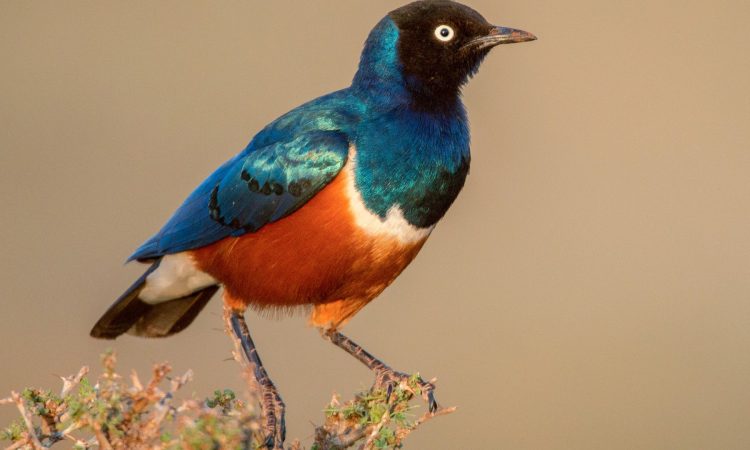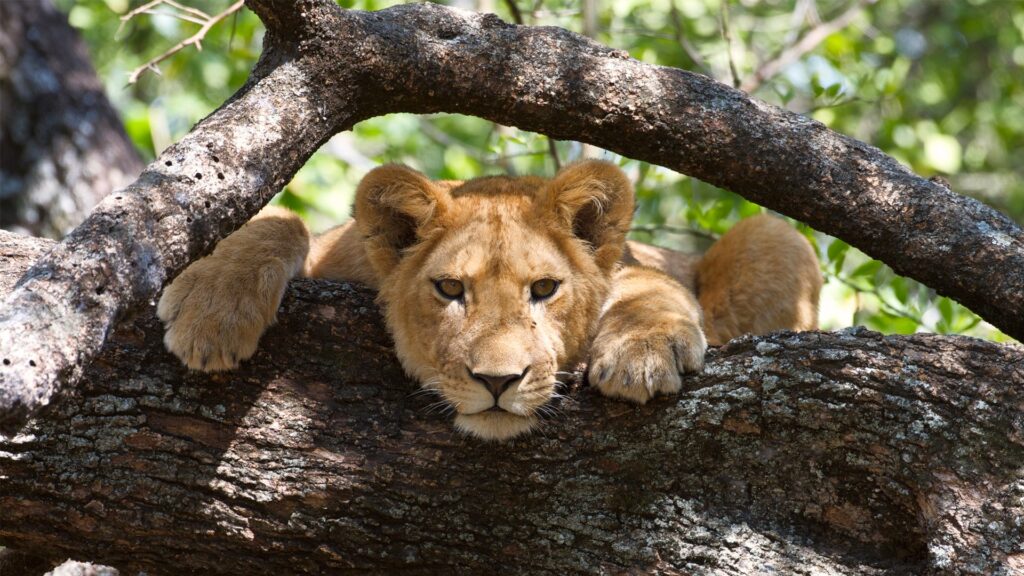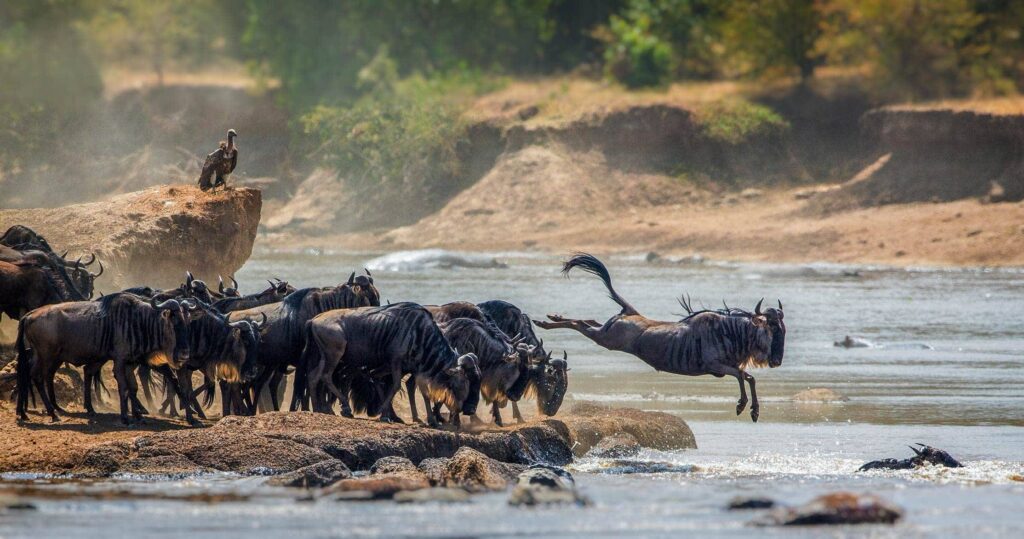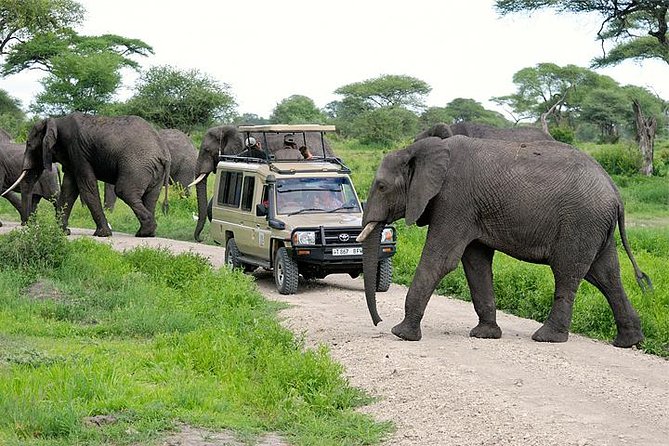The Rift Valley escarpment runs through Lake Manyara National Park, which is a small park at the base of the escarpment. The park is sized 330 square kilometers of which 220 sq kilometers are form the lake when the water levels are high in the rainy season. Its groundwater forest is a great change of pace from the parks that are primarily dominated by grasslands. During the wet season, the park is noted for its tree-climbing lions, but big cats are rarely sighted. Apart from the tree-climbing lion, elephants are abundant and are the major attraction.
In a small area, the park features a surprising diversity of habitats. The park entry leads to a lovely groundwater forest, which provides a wonderful change of scenery from the parks that are more savannah-dominated. The grassy floodplain, rocky escarpment, and acacia forest are among the other habitats that can be explored during your visit to this tree-climbing Lion Park in Tanzania.
From its Rift Valley soda lake to dense woodlands and steep mountainsides, Lake Manyara National Park offers a wilderness experience in a variety of environments. More than 400 species of birds, many of them water lover or migratory, flock to the lake’s beaches, which are covered with pink flamingos. Buffalo, cheetah, Masai giraffe, and impala inhabit the lakeshores and forested valley slopes in large groups. Other park occupants include the Cape clawless otter, Egyptian mongoose, hippo, and klipspringer.
WEATHER IN LAKE MANYARA
The dry season and the wet season are the two main seasons of Lake Manyara National Park, each of which has its own set of benefits in tourism.
The Dry Season
During the months of June to October, the park enjoys its dry season, which is also known as the main tourist season. The short dry season occurs in January and February, when a huge number of tourists rush the park, resulting in more expensive safari tours due to the high demand for housing. Animals congregate near the few surviving water sources at that time of year, and because the foliage is sparse, they are plainly visible.
This is also a great season to visit because there is a lot of sun with minimal rain, and because there are fewer mosquitoes, there are fewer possibilities of acquiring malaria. It is recommended that you pack appropriate clothing for early morning game drives during this time of year because it becomes cold in the mornings.
The wet season
The wet season lasts from November to May in Lake Manyara National Park. The arrival of the rains breathes new life into the park’s landscape, reviving the dried plants and revealing a magnificent green scenery once more. The rates are generally lower because the site is less congested during the low season, which is April and May. Although the best animal watching occurs during the dry season, Lake Manyara National Park offers excellent wildlife viewing throughout the year. During the wet season, many migratory birds may be spotted in the park, making it the best time to see Lake Manyara birds.
GETTING TO MANYARA NATIONAL PARK
Lake Manyara National Park, like the Serengeti and Ngorongoro conservation areas, is part of Tanzania’s famous northern safari circuit, but it is not as well-known as the other safari locations on the circuit. The majority of safaris on this particular circuit to Lake Manyara National Park begin in the town of Arusha.
You can enter the park from either the southern or northern gates. Because most lodging is located near the northern gate, it is used more frequently. The distance between Arusha and Lake Manyara National Park is 126 kilometers, or 90 minutes by car. The following are the two main modes of transportation used to reach Lake Manyara National Park:
By air transport.
Lake Manyara Park is best reached by flying into Kilimanjaro International Airport (KIA). Or if you’re at Dar es Salaam at Julius Nyerere International Airport, you can select to go to Arusha airport, from where you can acquire a domestic flight to Lake Manyara national park. Domestic flights are available through a domestic airline.
By road transport
The distance between Arusha and Lake Manyara National Park is 126 kilometers (78 miles), and it is easily accessible by automobile. You can also get there in a flexible manner from Babati, the capital of the Manyara region. This is the most popular mode of transportation for visitors to the park on the northern safari circuit.
If you don’t have access to a car, you can take public transportation to Mto WA Mbu village and then rent one to get inside the park. On the road to Lake Manyara National Park, car transportation always provides a spectacular view of many habitats.
WHEN IS THE BEST TIME TO VISIT LAKE MANYARA NATIONAL PARK?
Lake Manyara National Park is a year-round Tanzania safari destination, although the dry season, which runs from June to October and January to February, is regarded as the best period for game viewing, and there is good road access to the park during this time. Rains make the inner roadways slick and difficult to navigate during the wet season, which runs from November to December and March to June. Nonetheless, the best time to see birds in Lake Manyara is during the rainy season.
WHAT TO SEE/ATTRACTIONS IN LAKE MANYARA NATIONAL PARK
Within Lake Manyara National Park, there are a variety of unique tourist sites to discover. Apart from tree-climbing lions and a greater elephant population, Manyara National Park offers a variety of animal watching opportunities, including buffalo and zebras, as well as water-loving species around the lake. Another must-see attraction in this wonderful park is the many habitats, which range from ground-water forest to acacia tortilis land.
The top attractions and things to do in Lake Manyara National Park are indicated below.
Lake Manyara
The lake is small and shallow. Manyara is an alkaline lake in this park that swells and shrinks in size depending on the seasons and is surrounded by a long, silvery bowl of salt deposits. It comprises 220 square kilometers, or two-thirds of the park’s entire surface area. The lake is home to a great number of pink flamingos as well as other animals such as hippos that live in the river’s shallows.
From its Rift Valley soda lake to dense woodlands and steep mountainsides, Lake Manyara National Park offers a wilderness experience in a variety of environments. More than 400 species of birds, many of them waterfowl or migratory, flock to the lake’s beaches, which are covered with pink flamingos. Buffalo, cheetah, Masai giraffe, and impala inhabit the lakeshores and forested valley slopes in large groups.
Wildlife in Lake Manyara National Park
The game in Lake Manyara includes elephants, wildebeests, giraffes, and buffaloes in plenty. The park is also known for its large population of zebras, impalas, warthogs, and waterbucks. The game drive circuit is limited and may be completed in 3 to 4 hours, allowing you to witness the animals that are always on the move.
Tree Climbing Lions in Lake Manyara National Park
Tree-climbing lions may be found and are among the lions residing in Lake Manyara, with the other population being in the Ishasha Area of Queen Elizabeth National Park in Uganda. The park attracts a great number of tourists and photographers who come to observe these incredible animals.
Birds in Lake Manyara
The enormous number of birds that can be found at Lake Manyara National Park varies depending on the habitat and season. On the lake, you’ll frequently witness large groups of pelicans and pink flamingos, while near the park’s borders and floodplains, you’ll observe egrets, stilt herons, spoonbills, stalks, and other waders. The more fascinating species, such as crowned eagles, crested guinea fowl, and silvery-cheeked hornbills, will also be seen in the evergreen forests.

Lake Manyara’s Vegetation
A long, narrow park, set beneath the spectacular Great Rift Valley’s sheer western escarpment, protects the area between the escarpment and Lake Manyara. Wide grassy flood plains can be found near the lake, and areas of mixed acacia forests can be seen further away. Aside from that, there are pockets of enchanting evergreen forests adjacent to the escarpment, which are sustained by perennial groundwater springs from the escarpment’s base.
The large numbers of elephants
Apart from Tarangire National Park, which ranks first in Tanzania for the number of elephants it hosts, this national park is home to a significant number of elephants that can be easily observed in the evergreen forests and acacia woodlands. The abundance of ground water as well as the lush flora offer enough food for these forest giants.
WHAT TO DO IN LAKE MANYARA NATIONAL PARK/ TOURISM ACTIVITES
Game drives are conducted both during the day and at night.
Game drives are available both during the day and at night. Depending on tourist preferences, day game drives can be done in the morning, afternoon, or evening. Manyara National Park is situated along the lower slopes of the Great Rift Valley in the Great Rift Valley. Expect to witness a variety of wild animals during the day, including elephants, buffalo, lions, antelopes, and cheetahs, as well as bird species and stunningly magnificent woodland vegetarians. If you’re lucky, you’ll see lions glowing on trees (tree climbing lions), but this is only possible if you arrive for a month.
Because of the park’s stillness, which allows only the sounds of the animals to be heard across the park, night game drives are particularly beneficial for nocturnal species and birds. It’s as if you’ve stepped into another world.
Walking safaris
The Manyara walking track climbs and descends the hills. It always takes place in an environment with a large population of animals and lush vegetation. This is done to bring people closer to nature while also allowing them to see wild animals up close. It is always a type of activity that is accompanied by armed guards to ensure that tourists are protected from hazardous animals.
Canoeing
It’s primarily done at Lake Manyara, where it’s a type of activity that allows visitors to see the steep escarpment patched with evergreen forests while also getting up close and personal with a variety of aquatic species, including water-loving species like African jacana and both lesser and greater flamingos.
Bird watching
Aside from tree-climbing lions and the Big Five, Lake Manyara is a well-known birding hotspot with over 400 recognized species, giving tourists the opportunity to witness over 100 different bird species per day. Birding at Lake Manyara national park can be done all day, although the best times to go are early in the morning and late in the evening.
Filming and photographing
Visitors are encouraged to record and photograph their own life memories, and Lake Manyara national park is an ideal location. With so many attractions, as well as so many stunning filming sites, a photographer will be delighted to capture a dozen images for their lifelong memories.
WHERE TO STAY/ TOURISM ACCOMODATIONA AT LAKE MANYARA NATIONAL PARK
Within the park, there are luxury lodges, hostels, Bandas, and a variety of campsites, including special, public, and seasonal campsites, where you can spend the night. The following are some of the lodges in Lake Manyara National Park:
- Lake Manyara serena safari lodge
- Lake Manyara tree lodge
- Lake Manyara wildlife lodge
- Migugu tented lodge.
- Lake Manyara kilimamoja lodge
- Kirurumu Manyara lodge
- Manyara wildlife safari camp.



